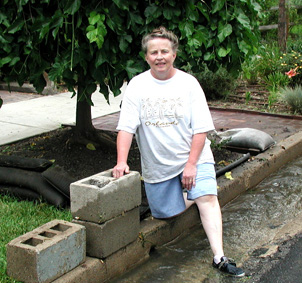Urban Irrigation Water
Early Utah water rights continue to be used in Salt Lake City under an 1888 Exchange Agreement.
LeRoy W. Hooton, Jr.
August 6, 2002
|
Ask Carel McDonough, 1000 South 900 East, what she thinks about having irrigation water and she’ll tell you it’s great. “I’m happy with this irrigation water, I like the open flow – it’s ecologically sound,” she says. Carel has been using the irrigation water on her property for over 30 years, continuing a practice that dates back to 1898 when her home was built. Placing a cinder brick-sand bag dam in the gutter allows the diversion of water onto her property. The original lateral ditch runs through her back yard, distributing the water to her lawn and garden.
Carel receives her irrigation water as a member of the Parley's Water Users Association and is part of the early plan of Mormon leader Brigham Young to settle the Salt Lake valley. Shortly after arriving in 1847, the city was laid out in 10-acre blocks with each block divided into 8 lots with ample space to plant greenery and gardens. The southern boundary of the city blocks ended at 900 South Street. A year later, a plan for distributing farm lands south of the city blocks was established. The “Big Field Survey” consisting of five-acre plots immediately south of 900 South to 2100 South and ten-acre plots from 2100 South southward provided a vast community farming district. The lands were distributed by applicants filing with the settlement’s clerk. The primary source of water supply to irrigate the Big Field Survey 5-acre plots and a portion of the 10-acre plots was Parley's Creek. The first year 900 applicants were given land and water to build their homes and establish farms.
In the beginning water for irrigation was apportioned on the basis of the amount of land being utilized. Diversion dams and ditches were constructed on a community basis. However, in time the water right and land ownership shifted from a community relationship to individual ditch rights. At the turn of the 20th Century, the district courts adjudicated the water rights based on a quantity of water (called a duty) required for each acre of land under irrigation. The Parley's Creek water rights were adjudicated in the 1912 Morse Decree. Judge Morse decided the primary water rights for the irrigation of nearly 2,500 acres of land. First through sixth surplus rights were further decreed.
|
The exchange was beneficial to both the city and the farmers. The exchange of waters was made in 1888. A reservoir and pipeline was constructed by the city in 1892 to convey high quality Parley's Creek water to Salt Lake City residents. Over the next 50 years similar exchanges with other mountain stream owners increased the City’s mountain water supplies from Mill Creek, Big and Little Cottonwood Creeks.
With population growth, the open fields began to disappear as homes displaced the former farmlands. The construction of public streets replaced segments of the irrigation ditch system, thus the streets become part of the irrigation system. In time the streets became the primary waterway conveying water from the Jordan & Salt Lake City Canal to the farmer’s head gates or diversion points. The farmers then conveyed the water through their private laterals to irrigate gardens, lawns and fields. This practice continues today.
Today water department (Department of Public Utilities) employees operate and maintain the canal system that conveys water from Utah Lake. Diversion points along the canal system deliver irrigation water to the various exchange irrigators, including the Parley's Water Users Association. Rising early in the morning, water masters turn water out of the Jordan and Salt Lake Canal and track the flow of water down the street gutters to the various turnouts. Once the water reaches the user’s diversion point, the user is then responsible for getting the water to his or her property.
Irrigation system supervisor Tim O’Hara is responsible for meeting Salt Lake City’s exchange agreement obligations along eastern Salt Lake County. He personally knows many of the Parley's water users. “The water users are willing to take the time and effort to make irrigation work,” says O’Hara. “They diligently take their two hour turn every week to water their properties, following the tradition that dates back to the pioneers.” Besides the beneficial use of the water, the work of irrigating builds neighborhood cooperation and friendship. According to O’Hara, “The irrigators work together to coordinate the distribution of water from one user to the other.” In this case quips O’Hara, “Water’s not for fighting for, just watering the garden.”
Related links:
An AWWA National Landmark:The Jordan & Salt Lake City Canal http://www.slcclassic.com/utilities/news06062000.htm
Pioneers of ‘47 - Pioneer Irrigators http://www.slcclassic.com/utilities/NewsEvents/news7221999.htm

